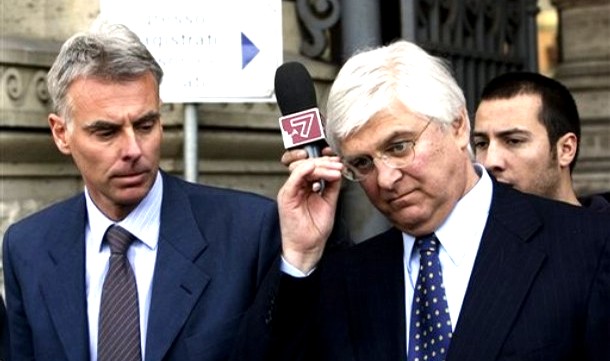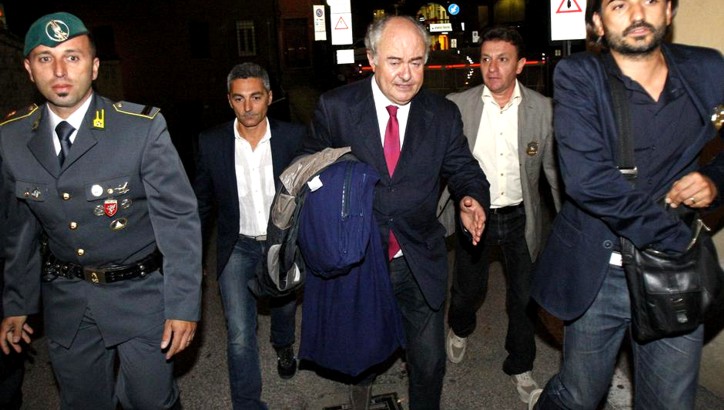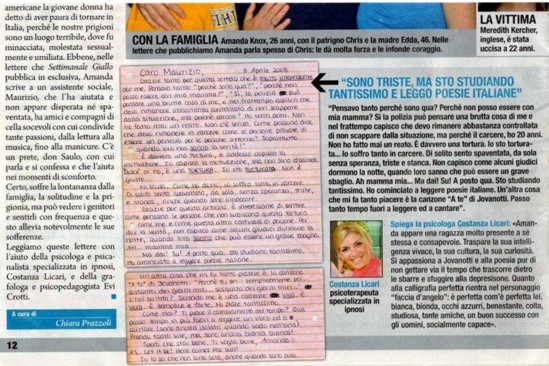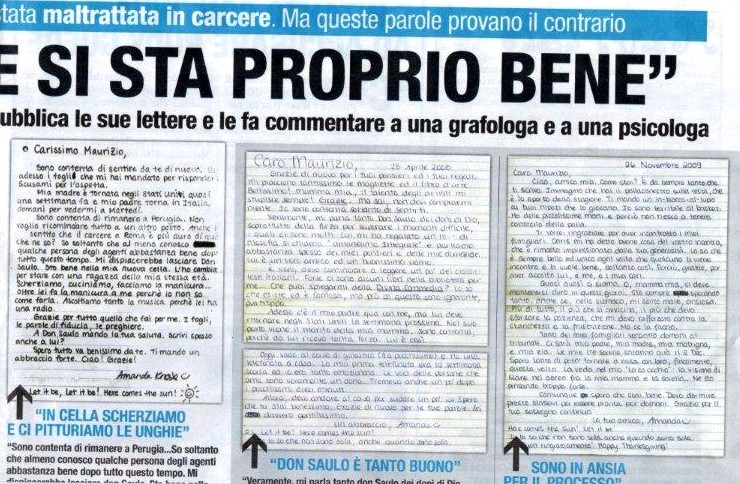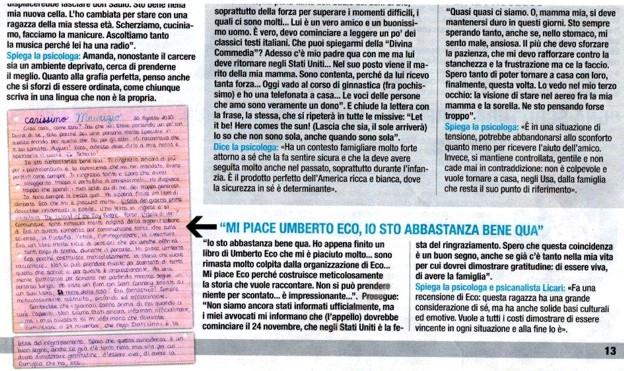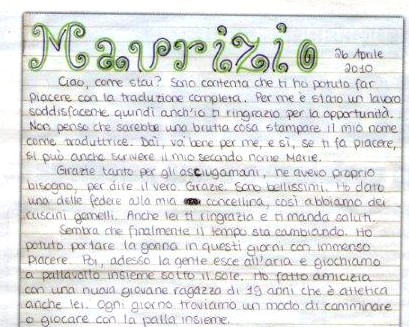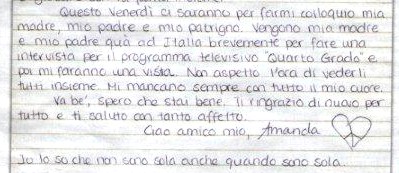
Category: 9 Mignini v Knox hoax
Wednesday, January 15, 2014
Mignini And Giuttari Win Final Round In Spurious 2010 Conviction By Rogue Prosecutor And Judge
Posted by Peter Quennell
Poison pill sown in 2006
The entire edifice of the Knox PR campaign was always built on a foundation of sand.
Years ago, the wannabe real-crime-reporter Doug Preston was shaken to the core when Dr Mignini and others figured out with the help of court-authorized wire-taps that he and Mario Spezi were planting evidence and using fake IDs to frame someone they had wrongly concluded was the “real” murderer in the Monster of Florence case.
In uncalled-for retaliation (he got off very lightly and could have faced a prison term) Preston went back to the US and, safe there, wrote a nasty and largely fictional book. He repeatedly claims it was really the cops and specifically Dr Mignini not Preston & Spezi who were dumb and blundering in not sufficiently investigating and charging the “real” murderer.
Fast-forward to 2008
Almost nobody in Italy supports Preston’s and Spezi’s “solution” to the MOF crime which they seemed to hope would bring them big bucks and whole new careers. That solution is widely regarded as a joke and there is voluminous evidence against it.
Nevertheless, Preston’s MOF book is published in the US, demonizing Mignini in great detail.
Knox PR aide David Marriot and his media pet poodles and online thugs, including the wild-eyed Paul Ciolino of CBS and the bizarro Frank Sforza of Perugia, were all over the notion that it was Mignini and not Preston & Spezi who had done something seriously wrong.
The mafia always has an interest in taking Italian justice down a peg, and opportunities were increasingly seen here. The mafia’s various useful idiots in the US (John Douglas, Saul Kassin, Dempsey, Burleigh, Steve Moore, Michele Moore, Heavey, Fischer, Doug Bremner, Hampikian, Halkidis, and some others) who have plagued a correct understanding of the MOF and Perugia cases all helpfully all piled on.
Fast-forward to January 2010
Dr Mignini and the former head of Florence detectives Michele Giuttari were convicted in Florence on spurious grounds. See our posts back then by Commissario Montalbano and TomM.
The purpose of the Florentine investigation against Mignini and Giuttari was obviously a pretext, a ploy aimed at blocking the seemingly very threatening Narducci arm of the MOF investigation. In fact it was a pretext for the rogue Florence prosecutor seizing the Narducci case file back from Dr Mignini in Perugia and burying it out of sight.
Nevertheless, the demonization of Mignini became even more shrill, multiplied globally by the gullible Joel Simon of the New York-based Committee to Protect Journalists in foolishly protecting the proven liar Frank Sforza who is now facing THREE trials.,
Fast-forward to November 2011
The Florence appeal court reverses the 2010 convictions because the case was brought by the SAME rogue Florence prosecutor who was caught on tape meddling in the Narducci investigation and who was one of those (there were others) trying to slow it down or destroy it.
Fast-forward to January 2013
The Supreme Court scathingly endorses that reversal. The attempt from within the Florentine court to de-legitimize the Narducci arm of the MOF investigation was from now on definitively at a dead end.
The investigations and trials of those who had for mysterious reasons been hampering the Narducci investigation were also put back on track by Cassation. Most threatened is Doug Preston’s mate Mario Spezi. He seems headed for a prison sentence for sure, leaving Preston (a major meddler in Meredith’s case) also legally very exposed..
Fast forward to April 2013
Dr Mignini is promoted, gaining very high marks in a competitive process. From this point on he will handle only appeals, and when Dr Galati retires (expected soon) Dr Mignini is expected to be the #1 prosecutor of the Region of Umbria.
Fast forward to summer 2013
The Turin prosecution office finally obtains the investigation file on Mignini and Giuttari from Florence as the Florence appeal judge and Cassation had instructed.
The investigation file should have been sent in November 2011 for action leading to full closure on the substance, but the Florence prosecutors illegally sat on it, presumably fearful of what could happen to him.
The Turin prosecution office had little interest in re-opening what seemed a dead-end and frivolous case. If this was what Mignini and Giuttari had wanted, the charges could have been dropped, but without any court finding of “not guilty”.
However, Dr Giuttari and Dr Mignini explained that they wanted a court finding of “not guilty” on the merits of the case. They WANTED the Turin court to read the evidence and to make a final ruling.
Fast forward to today
The Turin court did meet. Andrea Vogt posted this report.
For those keeping track of the various “sideshows” in the Amanda Knox case, a Turin court Wednesday definitively acquitted Perugia prosecutor Giuliano Mignini of three charges against him in connection to his investigations into the Monster of Florence case. The court shelved another three charges because the statute of limitations had expired. One abuse of office charge involving the wiretapping of a La Stampa journalist will be heard in court on March 18, but its statute of limitations appears to expire just days before, so it is unclear if the case will go forward. None of the matters relate directly to the Amanda Knox case, but they were often referenced by the prosecutor’s detractors.
And what next
The Italian justice system protects its senior judges and prosecutors from criminal defamations intended to obstruct justice with some powerful measures. They were originally intended to keep the mafia in its place as defamation of police, prosecutors and judges is one of its mainstays.
All of the false claims about Dr Mignini are still out there. Preston’s book is still on sale. So is Burleigh’s, Dempsey’s, Fischer’s, and John Douglas’s. Joel Simon’s seriously wrong claims are still online. Not one has recanted or wound back.
Knox and Sollecito each repeated the baseless claims at length in their books, and even embellished them. Michael Heavey parrots them to the State Department. They are the main crutch of Bruce Fischer, Steve Moore, Michele Moore, Doug Bremner, and so on.
However, the required pushback by Florence prosecutors and others has begun, and with today’s ruling will accelerate. Frank Sforza is already on trial for calunnia and the Italian justice system is quietly zeroing in on many others, all the book publishers included.
On March 14 the magazine Oggi which published many of Amanda Knox’s baseless claims in Italian must appear in court in Bergamo. Knox and Sollecito themselves may find a heap of new legal troubles after the appeal verdict is announced on 30 January.
*****
Numerous posts by Kermit and Yummi still need to be linked to.
Sunday, November 03, 2013
Knox Apologists Attempt To Bend Congress; But Nobody Important Turns Up
Posted by Our Main Posters
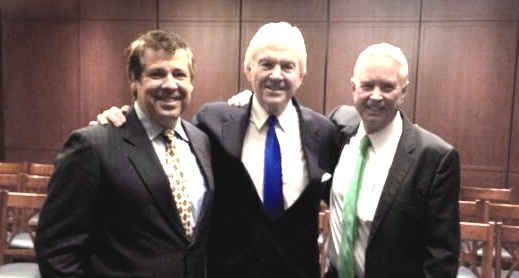
From the left: Steve Moore, John Douglas, and Michael Heavey.
In a room for hire at the Congress they made presentations of their misleading takes on the case to a near-empty room.
Senator Cantwell was apparently there briefly but took off as soon as she could. No other elected leaders were seen to be there.
There was seemingly no media coverage except for a sole post by another Knox apologist on the Infamous Ground Report.
These are hardly the most impartial or for that matter truthful and accurate observers of the case.
Click through for our numerous takedowns of the hapless Steve Moore, and John Douglas, and Michael Heavey.
Sunday, October 06, 2013
Dr Mignini Pushes Back Against His Demonizers Trying To Ascribe Non-Existant “Satanic Theory”
Posted by Peter Quennell
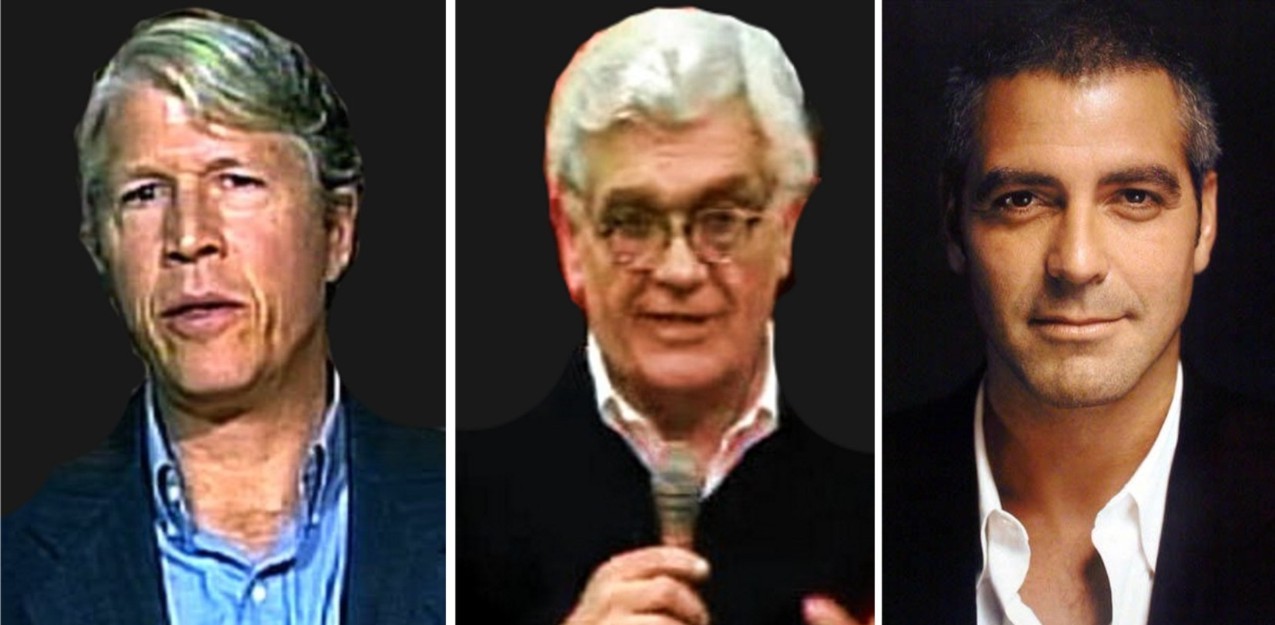
[Preston left, Spezi center, and George Clooney who is at legal risk for his option on their defamatory book]
1. Dr Mignini’s Published Statement
To the editor of Florence Corriere
Dear Director,
I am Giuliano Mignini, the magistrate who performed the investigation and trials of first instance and appeal in Perugia against the people accused of the murder of Meredith Kercher, as well as the investigation into the death of Francesco Narducci linked to the one performed by the Florence Prosecution Office in relation to the masterminds of the “Monster of Florence” murders.
I saw reported the interview that the journalist Mario Spezi ““ a person accused in the Narducci case ““ did with Amanda Knox, a main defendant in the appeal trial that will start today ““ published in the Corriere Fiorentino on Sep. 29.
In two recent cases the Court of Cassation has annulled verdicts, which acquitted Knox and Sollecito, and which decided [by Judge Micheli] a dropping of charge against Spezi (the parts regarding “˜lack of certainty about malice’ were annulled too).Therefore I don’t need to add anything further on that point. Instead, I need to point out the falsehood of an assertion which Mr. Spezi makes at the beginning of his article, as he tries to explain the reason for a link which, in his opinion, allegedly exists between the two cases, the one related to the Monster murders and Narducci’s death, and the one about the Kercher murder.
Mr. Spezi’s text says: “”¦ a strangely similar background, for two different cases, behind which the magistrate thought he could see satanic orgies on the occasion of Halloween for Amanda, and ritual blood sacrifices as a worship to the Devil in the Monster of Florence case”¦”.
This is an assertion that Mr. Spezi and crime-fiction author Douglas Preston have been repeating for years, but does not find the smallest confirmation in the documentation of the two trials, nor in the scenario put forward by the prosecution in which the Meredith murder (which didn’t happen on Halloween but on the subsequent night) was the consequence of a sex hazing to which Meredith herself did not intend to take part, and, above all, it was the consequence of a climate of hostility which built up progressively between the Coulsdon girl and Amanda because of their different habits, and because of Meredith’s suspicion about alleged money thefts by Knox.
Furthermore the object of the proceedings in the Narducci case is the scenario about the murder of the same Narducci and the attempt, by the doctor’s father and brother, to conceal the cause of his violent death, and this included the background within which the event ““ which was a homicide in my opinion and in the opinion of my technical consultant, coroner Prof. Giovanni Pierucci of the University of Pavia ““ had developed and taken place.
I had already denied several time assertions of such kind, but Mr. Spezi and Mr. Preston, and some people connected to them, go on repeating a lie, apparently hoping that it will become true by repeating it.
Another astonishing fact is that, despite that I was the prosecutor in the Kercher trial together with my colleague Manuela Comodi and then subsequently with my colleague Giancarlo Costagliola [at annulled apeal], and despite that I limited myself to formulating judicial requests which were all agreed to by a multitude of judges and confirmed by the Supreme Court, I am still considered as the only one responsible for an accusation against Ms. Knox and Mr. Sollecito, by twisting its content in various ways.
In the Narducci case, in the same way, I simply limited myself to performing the investigation and requesting the remands to trial, and the trial will have to start again now because the Supreme Court has annulled the dropping of charges [by Judge Micheli] and sent back the trial to another preliminary judge in Perugia.
The purpose ““ quite overt ““ of such endlessly repeated lies, is to defame the investigator, picturing him as a magistrate who is following alleged personal obsessions rather than sticking at facts, as instead he is.
The hope that such conscious misrepresentation of reality could bring advantage to the defences (foremost that of Spezi himself) is consistent with a bad habit which has all along flourished in Italy but is now also copied abroad.
Therefore I ask you to please publish my rectification against false and seriously defamatory information.
Kind regards
Giuliano Mignini
2. Context: The Mafia Playbook Adherents
As we have often d previously, the mafia and their handmaidens strive constantly to bring the Italian justice system down a peg or two.
When not using dynamite, as they often did in the past, they especially favor the weapon of character assassination of witnesses, judges prosecutors and police.
The vilification campaign being run in the United States by David Marriott, Chris Mellas, Doug Preston, Bruce Fischer, Steve Moore, Michelle Moore, Nigel Scott, and David Anderson (and from Italy by Frank Sforza) seems to be right out of the mafia playbook, whether all of them know it or not.
How the mafia have been using the public relations campaign to their own advantage seems set to emerge further in at least five of the associated trials coming down the pike: those of Luciano Aviello, Frank Sforza, Mario Spezi, Raffaele Sollecito (his book trial) and Amanda Knox (her book trial).
And now Mario Spezi, obviously a real glutton for punishment, once again piles on. Spezi has had incessant run-ins with the Italian law - and now he seems to have entered some kind of self-immolation end-game.
With Doug Preston, Spezi published several editions of their Monster of Florence scenario. These are widely discredited in Italy, not least because they are such obvious attempts to apply lipstick to a pig (half of the text is about an obviously red-handed and very very scared Preston trying to prove he did not actually melt down under interrogation for his probable felony interference in a case.)
Spezi has been charged with interfering with and hampering both the Monster of Florence investigations and the related investigation (which involved Dr Mignini) into the Narducci drowning - a clear murder (the body was found bound and another substituted) though a nefarious group worked very hard to deny that. (They were all charged as well, and the Supreme Court has recently confirmed the correctness of that.)
In recent weeks the Supreme Court has given a firm order for both prosecutions against Spezi to go ahead. How Spezi stays out of prison if he is found guilty is anyone’s guess. Doug Preston came up with a calamity of an explanation for the arrest of Frank Sforza for domestic violence, but presumably his assistance wont be sought this time around.
So in face of impending prison Spezi really watches his tongue, right?
No, in fact in a move bizarre even by his own standards, Spezi on 29 September published a surreal “interview” with Amanda Knox in Florence Corriere. It once again repeats the felony claim that the prosecution charged Knox and Sollecito in the first place based only on some “satanic theory”.
The Perugia prosecution has never never NEVER claimed that. The Florence prosecutor has already moved into felony-investigation mode (this could cost Spezi more years in prison) and on 3 October Florence Corriere published this correction below by the defamed prosecution (translation is by Yummi).
This unequivocal statement (far from the first but the most prominent) has its own legal status. It is a clear legal warning to the likes of Chris Mellas and Bruce Fischer that if they sustain the libel they are at risk of felony charges also.
The statement has already had a strong ripple effect in Italy. Many former allies - some of them not very savory - now feel that Spezi has lied to and betrayed them for his own ends.
Sunday, June 16, 2013
Questions For Knox: Do You Really Think “False Memories” Claim Framing Italians Yet Again Will Help?
Posted by Our Main Posters

[You say Madison Paxton found Kassin? So why did Bruce Fischer and Sarah claim to have done so??]
1. Your Real Persona, Widely Observed
Remember that Italians have seen a lot more of the real you than most Americans ever have. Italians all saw the real you described here and here.
That is why maybe 95% of all Italians long ago concluded for your guilt. At times you can come across as winning but, as there on the stand, too often as brash, sneering, sharp-elbowed, humorless, uncaring, and self-absorbed.
That is the Knox that put off many who encountered you in Seattle, it is why you had Halloween largely alone, and why you put off almost everyone you encountered in Perugia. Including everyone in your house in Perugia, and most in Patrick’s bar - and this literally in less than a month.
The “lost little girl” persona, the “chaste girl who never did sex and drugs” persona, the “diligent girl who studied so hard” persona, and the “they all want to get me because I am so fantastically cute” persona you or your agenda-driven shadow-writer put in the book have many people who have seen a lot of you in strong disbelief.
Can you name even one good friend who still stands by you in Perugia, given that even Raffaele Sollecito has placed you at the brink of a cliff?
By the way, this is not an unkind group, mostly comprised as it is of professionals, and some surprising things you yourself said in your book confirmed a suspicion about untreated root causes that we mentioned here.
2. Pages 270 to 272 Of Your Book With Your False Claims Highlighted
Let us first quote what you claim about your interrogation as “explained” by Saul Kassin who had at this point diagnosed you only long-distance and talked with not even one person who was there. False claims are shown in bold.
Thankfully Madison had researched the science on false confessions. She found Saul Kassin, a psychologist at John Jay College of Criminal Justice in New York. A specialist in wrongful convictions, he took the mystery out of what had happened to me.
Before my interrogation, I believed, like many people, that if someone were falsely accused, they wouldn’t, couldn’t, be swayed from the truth while under interrogation. I never would have believed that I could be pressured into confessing to something I hadn’t done. For three years I berated myself for not having been stronger. I’m an honest person. During that interrogation, I had nothing to hide, and a stake in the truth “” I desperately wanted the police to solve Meredith’s murder. But now I know that innocent people often confess. The records kept of people convicted of a crime and later exonerated by DNA evidence show that the DNA of 25 percent of them didn’t match the DNA left at the scene. The DNA testing showed that one in four innocent people ended up confessing as I did. And experts believe that even more innocent people confess, both in cases with and without DNA evidence.
According to Kassin, there are different types of false confessions. The most common is “compliant,” which usually happens when the suspect is threatened with punishment or isolation. The encounter becomes so stressful, so unbearable, that suspects who know they’re innocent eventually give in just to make the uncomfortably harsh questioning stop. “You’ll get thirty years in prison if you don’t tell us,” says one interrogator. “I want to help you, but I can’t unless you help us,” says another.
This was exactly the good cop/bad cop routine the police had used on me.
Besides being compliant, I also showed signs of having made an “internalized” false confession. Sitting in that airless interrogation room in the questura, surrounded by people shouting at me during forty-three hours of questioning over five days, I got to the point, in the middle of the night, where I was no longer sure what the truth was. I started believing the story the police were telling me. They took me into a state where I was so fatigued and stressed that I started to wonder if I had witnessed Meredith’s murder and just didn’t remember it. I began questioning my own memory.
Kassin says that once suspects begin to distrust their own memory, they have almost no cognitive choice but to consider, possibly accept, and even mentally elaborate upon the interrogator’s narrative of what happened. That’s how beliefs are changed and false memories are formed.
That’s what had happened to me.
I was so confused that my mind made up images to correspond with the scenario the police had concocted and thrust on me. For a brief time, I was brainwashed.
Three years after my “confession,” I’d blocked out some of my interrogation. But the brain has ways of bringing up suppressed memories. My brain chooses flashbacks””sharp, painful flashes of memory that flicker, interrupting my conscious thoughts. My adrenaline responds as if it’s happening in that moment. I remember the shouting, the figures of looming police officers, their hands touching me, the feeling of panic and of being surrounded, the incoherent images my mind made up to try to explain what could have happened to Meredith and to legitimize why the police were pressuring me.
This new knowledge didn’t stop my nightmares or flashbacks, but I was so relieved to learn that what I’d been through wasn’t unique to me. It had been catalogued! It had a name! As soon as I understood that what happened during my interrogation wasn’t my fault, I started forgiving myself.
Kassin and others show that interrogations are intentionally designed to bewilder and deceive a suspect. Originally created to get highly trained, patriotic U.S. fighter pilots to sell out their country during the Korean War, one technique uses a tag team of investigators and tactics meant to induce exhaustion, agitation, and fear. It’s especially potent on young, vulnerable witnesses like me. The method was designed not to elicit information but to plant it “” specifically tailored to destroy an orderly thought process. After some hours, the subject gives the interrogators what they want “” whether it’s the truth or not.
In my case they’d put several interrogators in a room with me. For hours they yelled, screamed, kept me on edge. When they exhausted themselves, a fresh team replaced them. But I wasn’t even allowed to leave to use the bathroom.
These were strategic measures, many of which are described in Kassin’s report on police interrogation, “On the Psychology of Confessions: Does Innocence Put Innocents at Risk?” Reading it, I was flabbergasted to learn how by the book the police had been in their manipulation of me.
It had been the middle of the night. I’d already been questioned for hours at a time, days in a row. They tried to get me to contradict myself by homing in on what I’d done hour by hour, to confuse me, to cause me to lose track and get something wrong. They said I had no alibi. They lied, saying that Raffaele had told them I’d asked him to lie to the police. They wouldn’t let me call my mom. They wouldn’t let me leave the interrogation room. They were yelling at me in a language I didn’t understand. They hit me and suggested that I had trauma-induced amnesia. They encouraged me to imagine what could have happened, encouraged me to “remember” the truth because they said I had to know the truth. They threatened to imprison me for thirty years and restrict me from seeing my family. At the time, I couldn’t think of it as anything but terrifying and overwhelming.
That was exactly their point.
Highlighted in bold is another large body of your many easy-to-disprove lies as in the previous post.
Your bizarre analysis leads to many many questions.
- What honest person? You served three years for felony lying. Exactly how did you ever help the police? What good cop/bad cop routine? There were only ever 2 or 3 interviewers there. What airless room? You were in a very modern building with air conditioning. What shouting? What 43 hours of interrogation? You had at most been questioned for one or two hours - and only for a few minutes on this night when you “broke”. What story were police forcing on you? Why were you so confused and stressed - other than that Sollecito had just left you with no alibi? What did the police concoct and thrust on you, and why? Why didnt they do that to anyone else? So many others were interviewed too.
You are not even in Kassin’s “vulnerable” target group. How could you possibly be brainwashed in such a short time? What do you mean “after some hours”? What hours? Who exactly yelled and screamed and kept you on edge? What fresh tag team? Who stopped you leaving the interrogation room for a bathroom break? Why did you testify that you were given refreshments and treated well? Why did your own lawyers say you were treated well? Why did they never lodge a complaint? Why when you had an excellent interpreter did you say you couldn’t understand? Why would police threaten to imprison you for 30 years when their whole interest moved quickly to Patrick as you engineered? And why after the interview when you were left sitting in a corridor, babbling and being calmed down, did you not simply walk right out?
In fact, nobody ever accused you of anything at all in your voluntary witness interview.
You were put under no pressure to confess. Not so long after Sollecito fingered you, you spontaneously blamed Patrick for Meredith’s death. For the next several hours, you babbled on, again and again blaming Patrick. Dr Mignini then witnessed you being warned, and barely said a word.
And of course you never ever did confess that you participated in the attack on Meredith yourself. You are really claiming a false confession - when you didnt even confess?
Sollecito similarly cracked spontaneously in an adjacent room, and he pointed the blame at you. Its very noticeable in all of the above that you essentially dont even mention his name. Nor does Kassin.
So what made Sollecito crack? You don’t explain that.
3. Saul Kassin’s Version with His False Claims Highlighted
It seems that Kassin was subjected to the toxic Misinformation Cloud conjured up by the Rank Amateurs for Knox, and Kassin very foolishly failed to check with anyone at all who had been on the spot.
Here are the relevant passages from Saul Kassin’s paper in American Psychologist with his false claims highlighted in bold.
As illustrated by the story of Amanda Knox and many others wrongfully convicted, false confessions often trump factual innocence. Focusing on consequences, recent research suggests that confessions are powerfully persuasive as a matter of logic and common sense; that many false confessions contain richly detailed narratives and accurate crime facts that appear to betray guilty knowledge; and that confessions in general can corrupt other evidence from lay witnesses and forensic experts””producing an illusion of false support. This latter phenomenon, termed “corroboration inflation,” suggests that pretrial corroboration requirements as well as the concept of “harmless error” on appeal are based on an erroneous presumption of independence among items of evidence. In addition to previously suggested reforms to police practices that are designed to curb the risk of false confessions, measures should be taken as well to minimize the rippling consequences of those confessions….
Meredith Kercher was found raped and murdered in Perugia, Italy. Almost immediately, police suspected 20-year-old Amanda Knox, an American student and one of Kercher’s roommates””the only one who stayed in Perugia after the murder. Knox had no history of crime or violence and no motive. But something about her demeanor””such as an apparent lack of affect, an outburst of sobbing, or her girlish and immature behavior”” led police to believe she was involved and lying when she claimed she was with Raffaele Sollecito, her new Italian boyfriend, that night.
Armed with a prejudgment of Knox’s guilt, several police officials interrogated the girl on and off for four days. Her final interrogation started on November 5 at 10 p.m. and lasted until November 6 at 6 a.m., during which time she was alone, without an attorney, tag-teamed by a dozen police, and did not break for food or sleep. In many ways, Knox was a vulnerable suspect””young, far from home, without family, and forced to speak in a language in which she was not fluent. Knox says she was repeatedly threatened and called a liar. She was told, falsely, that Sollecito, her boyfriend, disavowed her alibi and that physical evidence placed her at the scene. She was encouraged to shut her eyes and imagine how the gruesome crime had occurred, a trauma, she was told, that she had obviously repressed. Eventually she broke down crying, screaming, and hitting herself in the head. Despite a law that mandates the recording of interrogations, police and prosecutors maintain that these sessions were not recorded.
Two “confessions” were produced in this last session, detailing what Knox called a dreamlike “vision.” Both were typed by police””one at 1:45 a.m., the second at 5:45 a.m. She retracted the statements in a handwritten letter as soon as she was left alone (“In regards to this “˜confession’ that I made last night, I want to make it clear that I’m very doubtful of the verity of my statements because they were made under the pressures of stress, shock, and extreme exhaustion.”). Notably, nothing in the confessions indicated that she had guilty knowledge. In fact, the statements attributed to Knox were factually incorrect on significant core details (e.g., she named as an accomplice a man whom police had suspected but who later proved to have an ironclad alibi; she failed to name another man, unknown to police at the time, whose DNA was later identified on the victim). Nevertheless, Knox, Sollecito, and the innocent man she implicated were all immediately arrested. In a media-filled room, the chief of police announced: Caso chiuso (case closed).
Police had failed to provide Knox with an attorney or record the interrogations, so the confessions attributed to her were ruled inadmissible in court. Still, the damage was done. The confession set into motion a hypothesis-confirming investigation, prosecution, and conviction. The man whose DNA was found on the victim, after specifically stating that Knox was not present, changed his story and implicated her while being prosecuted. Police forensic experts concluded that Knox’s DNA on the handle of a knife found in her boyfriend’s apartment also contained Kercher’s blood on the blade and that the boyfriend’s DNA was on the victim’s bra clasp. Several eyewitnesses came forward. An elderly woman said she was awakened by a scream followed by the sound of two people running; a homeless drug addict said he saw Knox and Sollecito in the vicinity that night; a convicted drug dealer said he saw all three suspects together; a grocery store owner said he saw Knox the next morning looking for cleaning products; one witness said he saw Knox wielding a knife.
On December 5, 2009, an eight-person jury convicted Amanda Knox and Raffaele Sollecito of murder. The two were sentenced to 26 and 25 years in prison, respectively. Finally, on October 3, 2011, after having been granted a new trial, they were acquitted. [Actually they still stand accused - and facing a tough fact-based prosecution appeal] Ten weeks later, the Italian appeals court released a strongly worded 143-page opinion in which it criticized the prosecution and concluded that there was no credible evidence, motive, or plausible theory of guilt. For the four years of their imprisonment, this story drew international attention (for comprehensive overviews of the case, see Dempsey, 2010, and Burleigh, 2011).1
It is now clear that the proverbial mountain of discredited evidence used to convict Amanda Knox and Raffaele Sollecito was nothing but a house of cards built upon a false confession. The question posed by this case, and so many others like it, is this: Why do confessions so often trump innocence? ...
Third, it is important to realize that not all evidence is equally malleable or subject to corroboration inflation. Paralleling classic research indicating that expectations can color judgments of people, objects, and other stimuli that are ambiguous as opposed to those that compel a particular perception, forensic research indicates that ambiguity is a moderating condition. Asked to report on an event or make an identification decision on the basis of a memory trace that cannot be recovered, eyewitnesses are particularly malleable when confronted with evidence of a confession (Hasel & Kassin, 2009). This phenomenon was illustrated in the case against Amanda Knox. When police first interviewed Knox’s British roommates, not one reported that there was bad blood between Knox and the victim. After Knox’s highly publicized confession, however, the girls brought forth new “memories,” telling police that Kercher was uncomfortable with Knox and the boys she would bring home (Burleigh, 2011). ...
In recent years, psychologists have been critical of the problems with accuracy, error, subjectivity, and bias in various types of criminal evidence””prominently including eyewitness identification procedures, police interrogation practices, and the so-called forensic identification sciences, all leading Saks and Koehler (2005) to predict a “coming paradigm shift.” With regard to confessions, it now appears that this shift should encompass not only reforms that serve to minimize the risk of false confessions but measures designed to minimize the rippling consequences of those confessions””as in the case of Amanda Knox and others who are wrongfully convicted.
4. An Exposure Of Ten Of Saul Kassins’s False Claims
Our main poster the Machine exposes further how Kassin’s key claims are wrong.
False Claim 1: They brought her in for that final interrogation late at night.
No they didn’t.
Neither the police nor the prosecutors brought Amanda in for questioning on 5 November 2007. Amanda Knox herself testified in court that she wasn’t called to come to the police station on 5 November 2007.
Carlo Pacelli: “For what reason did you go to the Questura on November 5? Were you called?”
Amanda Knox: “No, I wasn’t called. I went with Raffaele because I didn’t want to be alone.”
Amanda Knox went with Raffaele Sollecito because she didn’t want to be alone. Kassin’s false claim is the first red flag that Saul Kassin is very confused or has been seriously misled when it comes to this well-documented and well-handled case.
False Claim 2: The so-called confession wasn’t until 6:00am.
No it wasn’t.
If Saul Kassin had actually read Amanda Knox’s first witness statement, he would have known that it was made at 1:45am. Knox had admitted that she was at the cottage when Meredith was killed some time before this.
False Claim 3: She was interrogated from 10:00pm to 6.00am.
No she wasn’t.
According to the Daily Beast Amanda Knox’s questioning began at about 11:00pm.
Since Knox was already at the police station [in the company of Raffaele Sollecito] the head of the murder squad decided to ask her a few questions. Her interrogation started at about 11 p.m.
After Amanda Knox had made her witness statement at 1:45am, she wasn’t questioned again that evening. That was it.
However, Amanda Knox herself then wanted to make further declarations and Mr Mignini who was on duty on the night sat and watched while Knox wrote out her declarations.
Mr Mignini explained what happened in his email letter to Linda Byron, another who was factually challenged.
All I did was to apply the Italian law to the proceedings. I really cannot understand any problem.
In the usual way, Knox was first heard by the police as a witness, but when some essential elements of her involvement with the murder surfaced, the police suspended the interview, according to Article 63 of the penal proceedings code.
But Knox then decided to render spontaneous declarations, that I took up without any further questioning, which is entirely lawful.
According to Article 374 of the penal proceedings code, suspects must be assisted by a lawyer only during a formal interrogation, and when being notified of alleged crimes and questioned by a prosecutor or judge, not when they intend to render unsolicited declarations.
Since I didn’t do anything other than to apply the Italian law applicable to both matters, I am unable to understand the objections and reservations which you are talking about.
In Amanda Knox’s written witness statement, she explicitly states that she’s making a spontaneous declaration:
Amanda Knox: “I wish to relate spontaneously what happened because these events have deeply bothered me and I am really afraid of Patrick, the African boy who owns the pub called “Le Chic” located in Via Alessi where I work periodically.
False Claim 4: They banged her on the back of the head.
No they didn’t.
All the numerous witnesses who were actually present when Amanda Knox was questioned, including her interpreter, testified under oath at trial in 2009 that she wasn’t hit. She has never identified anyone who hit her and on several occasions confirmed that she was treated well.
Even one of Amanda Knox’s lawyers, Luciano Ghirga, confirmed that Amanda Knox had not been hit: “There were pressures from the police but we never said she was hit.” He never ever lodged a complaint.
False Claim 5: All the other British roommates left town.
No they didn’t.
The police also told Sophie Purton that they needed her to stay on in Perugia on precisely the same basis as Amanda Knox. In chapter 19 of Death in Perugia, John Follain states that Sophie Purton was questioned by Mignini and Napoleoni in the prosecutor’s office on 5 November 2007.
Sophie had been counting on leaving Perugia to fly back home as soon as her parents arrived, but the police called to tell her they needed her to stay on; they would let her know when she could leave.
False Claim 6 : Amanda Knox stayed back to help the police.
No she didn’t.
This claim is flatly contradicted by Amanda Knox herself. In the e-mail she wrote to her friends in Seattle on 4 November 2007 she categorically stated she was not allowed to leave Italy.
i then bought some underwear because as it turns out i wont be able to leave italy for a while as well as enter my house
Knox actually knew on 2 November 2007 that she couldn’t leave Italy. Amy Frost reported the following conversation (The Massei report, page 37),
I remember having heard Amanda speaking on the phone, I think that she was talking to a member of her family, and I heard her say, No, they won’t let me go home, I can’t catch that flight.
It’s not the first time that the myth that Knox chose to stay behind rather than leave Italy has been claimed in the media. And incidentally, lying repeatedly to the police isn’t normally considered to be helping them.
False Claim 7: Amanda Knox had gone 8 hours without any food or drink.
No she hadn’t.
Reported by Richard Owen in The Times, 1 March 2009
Ms Napoleoni told the court that while she was at the police station Ms Knox had been ‘treated very well. She was given water, camomile tea and breakfast. She was given cakes from a vending machine and then taken to the canteen at the police station for something to eat.’
Reported by Richard Owen in The Times, 15 March 2009.
Ms Donnino said that Ms Knox had been “comforted” by police, given food and drink, and had at no stage been hit or threatened.
John Follain in his meticulous book Death in Perugia, page 134, also reports that Knox was given food and drink during her questioning:
During the questioning, detectives repeatedly went to fetch her a snack, water, and hot drinks including camomile tea.
False Claim 8: The translator was hostile towards Amanda Knox.
No she wasn’t.
Saul Kassin offers no evidence that the translator was hostile towards Amanda Knox and there is no evidence that this was the case. Nobody at the questura has claimed this. Amanda Knox’s own lawyers have not claimed this.
Even Amanda Knox herself has never ever claimed that Anna Donnino was hostile towards her although she had every opportunity to do so when being questioned on the stand.
False Claim 9: The translator was acting as an agent for the police.
No she wasn’t.
Saul Kassin offers no evidence to support this claim, which by the way in Italy is the kind of unprofessional charge that incurs calunnia suits. Do ask Curt Knox.
False Claim 10: The police lied to Amanda Knox.
No they didn’t.
The police didn’t mislead Amanda Knox. They told her quite truthfully that Sollecito was no longer providing her with an alibi, and that he had just claimed in the next interrogation room that she wasn’t at his apartment from around 9:00pm to about 1:00am. This also is the kind of unprofessional charge that incurs calunnia suits
Other claims by Kassin are also inaccurate. He claims that not one of your acquaintances had reported there was bad blood. That also is untrue. Even prior to the witness interrogation, law enforcement knew from multiple sources that you had been feuding with just about everyone. Acquaintances created no “new memory”. The bad blood you created was quite real.
5. How Kassin Bends His Own Science To Make Results Come Out “Right”
Our main poster Fuji dug deeper into the science and turns up what is an obvious scientific fraud by Kassin to insert himself into the case.
Meredith’s case is absolutely riddled with fabricated false myths.
They are now found by the hundreds on some misleading websites, and they simply make experienced law enforcement and criminal lawyers laugh.
For example “Police had no good reason to be immediately suspicious of Knox simply because the murder occurred at her residence”. And “The double-DNA knife is a priori to be disregarded as evidence, because no murderer would retain possession of such a murder weapon.”
One of the most strident and widespread myths is that Amanda Knox’s statements to the Perugian investigators on 5 and 6 November 2007, placing her at the scene of Meredith’s murder, are to be viewed as the products of a genuinely confused mind imbued with a naïve trust of authority figures.
The apparent certainty with which many of Amanda Knox’s most vocal supporters proclaim that Knox’s statements are actual “false confessions” as opposed to deliberate lies is not supported by even a cursory reading of the pertinent academic literature regarding false confessions.
What actually are “false confessions”?
Richard N. Kocsis in his book “Applied Criminal Psychology: A Guide to Forensic Behavioral Sciences” (2009), on pages 193-4 delineates three different kinds of false confessions:
First, a voluntary false confession is one in which a person falsely confesses to a crime absent any pressure or coercion from police investigators….
Coerced-compliant false confessions occur when a person falsely confesses to a crime for some immediate gain and in spite of the conscious knowledge that he or she is actually innocent of the crime….
The final type, identified by Kassin and Wrightsman (1985), is referred to as a coerced-internalized false confession. This occurs when a person falsely confesses to a crime and truly begins to believe that he or she is responsible for the criminal act.
The first problem facing Knox supporters wishing to pursue the false confession angle as a point speaking to her purported innocence is epistemological.
Although much research has been done on this phenomenon in recent years, academics are still struggling to come to terms with a methodology to determine their incidence rate.
The current state of knowledge does not support those making sweeping claims about the likelihood of Knox’s statements being representative of a genuine internalized false confession.
As noted by Richard A. Leo in “False Confessions: Causes, Consequences, and Implications” (Journal of the American Academy of Psychiatry and the Law, 2009):
Although other researchers have also documented and analyzed numerous false confessions in recent years, we do not know how frequently they occur. A scientifically meaningful incidence rate cannot be determined for several reasons.
First, researchers cannot identify (and thus cannot randomly sample) the universe of false confessions, because no governmental or private organization keeps track of this information.
Second, even if one could identify a set of possibly false confessions, it is not usually possible as a practical matter to obtain the primary case materials (e.g., police reports, pretrial and trial transcripts, and electronic recordings of the interrogations) necessary to evaluate the unreliability of these confessions.
Finally, even in disputed confession cases in which researchers are able to obtain primary case materials, it may still be difficult to determine unequivocally the ground truth (i.e., what really happened) with sufficient certainty to prove the confession false.
In most alleged false-confession cases, it is therefore impossible to remove completely any possible doubts about the confessor’s innocence.
The next problem Knox supporters face is that, even allowing for an inability to establish a priori any likelihood of a given statement being a false confession, the kind of false confession which is usually attributed to Knox is in fact one of the LEAST likely of the three types (Voluntary, Compliant, and Persuaded, as Leo terms the three different categories) to be observed:
Persuaded false confessions appear to occur far less often than compliant false confessions.
Moreover, despite assertions to the contrary, Knox and her statements do not in fact satisfy many of the criteria researchers tend to observe in false confessions, particularly of the Persuaded variety:
“All other things being equal, those who are highly suggestible or compliant are more likely to confess falsely. Individuals who are highly suggestible tend to have poor memories, high levels of anxiety, low self-esteem, and low assertiveness, personality factors that also make them more vulnerable to the pressures of interrogation and thus more likely to confess falsely…
Highly suggestible or compliant individuals are not the only ones who are unusually vulnerable to the pressures of police interrogation. So are the developmentally disabled or cognitively impaired, juveniles, and the mentally ill….
They also tend to occur primarily in high-profile murder cases and to be the product of unusually lengthy and psychologically intense interrogations… ordinary police interrogation is not strong enough to produce a permanent change in the suspect’s beliefs.
Most significantly, there is one essential element of a true Persuaded False Confession which in Knox’s case is highly distinctive:
To convince the suspect that it is plausible, and likely, that he committed the crime, the interrogators must supply him with a reason that satisfactorily explains how he could have done it without remembering it.
This is the second step in the psychological process that leads to a persuaded false confession.
Typically, the interrogator suggests one version or another of a “repressed” memory theory.
He or she may suggest, for example, that the suspect experienced an alcohol- or drug-induced blackout, a “dry” blackout, a multiple personality disorder, a momentary lapse in consciousness, or posttraumatic stress disorder, or, perhaps most commonly, that the suspect simply repressed his memory of committing the crime because it was a traumatic experience for him.
The suspect can only be persuaded to accept responsibility for the crime if he regards one of the interrogators’ explanations for his alleged amnesia as plausible.
Knox did not in fact claim drug or alcohol use as the source of her amnesia - rather, she claimed to have accepted the interrogators’ attribution that this was due to being traumatized by the crime itself, and she offers no other explanation for her selective amnesia:
This is from Knox’s statement to the court in pretrial on 18 October 2008 with Judge Micheli presiding.
Then they started pushing on me the idea that I must have seen something, and forgotten about it. They said that I was traumatized.
Of course, Knox’s initial statement went far beyond being that of being merely a witness to some aspect of Ms. Kercher’s murder, as the interrogators at first seemed to believe was the case.
Rather, her statement placed her at scene of the murder during its actual commission while she did nothing to avert it, which naturally made her a suspect.
In other words, in the absence of any of her other testimony which indicated that she was only a witness to the murder, her own self-admitted rationale for providing a false confession was that she was traumatized by the commission of the murder itself.
Perugia judges will be familiar with all of the above and we can be sure that they brief the lay judges on the remote circumstances and incidences of false confessions.
If I were a Knox defense attorney, I would find it to be a far more fruitful line of argumentation to argue that she was simply lying, rather than claiming the supremely unlikely provision of an actual internalized false confession.
6. Kassin’s Paper with Correct Facts and Context Now Included
Here is our main poster BR Mull describing what actually took place.
On November 2, 2007, British exchange student Meredith Kercher was found sexually attacked and murdered in Perugia, Italy. The next day, 20-year-old Amanda Knox, an American student and one of Kercher’s roommates, became a person of interest, along with Meredith’s downstairs neighbors and several of her other acquaintances. Interviewing close contacts is a cornerstone of police work. Two of Meredith’s close English friends, who were so scared they couldn’t sleep alone, left Perugia in the immediate aftermath of the murder. Everyone else stayed on.
Months before arriving in Perugia, Knox received a citation for a noise violation when a going-away party she’d thrown for herself in Seattle got out of hand. One of the officers described it as a “scene from Baghdad.” Within about three weeks of moving into the cottage in Perugia, Knox was ejected from a nightclub for pouring her glass on the head of a disc jockey.
It’s often said that Knox had no motive to kill Meredith, but it was Knox’s claim of drug use which indicated a possible motive: a drug-fuelled assault. There are various others, though a motive is not actually required for conviction. In crime scene videos from the day Meredith’s body was discovered, Knox can be seen outside the cottage glancing furtively around. Still, it was not this and other odd behavior, but rather the many conflicting witness statements by Knox and her new Italian boyfriend, Raffaele Sollecito, that led police to believe Knox was involved and lying when she claimed she was with Sollecito at his home continuously on the night of November 1.
Police interviewed dozens of witnesses in the days after the murder, some more than once. All witness statements were written down and signed for, not recorded. The police interviewed Sollecito for the third time beginning at 10:40pm on November 5. Knox later testified that she voluntarily accompanied her boyfriend to the station, because she didn’t want to be alone. The police did not summon her. To the interviewers’ surprise, Sollecito repudiated his earlier alibi when shown phone records, and now said Knox had left his apartment for much of the evening. Some time after 11:00pm the police asked if they might interview Knox. An interpreter was called and by 1:45am Knox had given a signed statement that she had witnessed the sounds of her employer, bar owner Patrick Lumumba, murdering Meredith at the cottage.
In that statement she acknowledged that she had been given an interpreter, and that she herself was now officially a suspect. Knox later testified that she was treated well. She was offered snacks and drinks during the interview and afterward. Made aware that she could not be interrogated without a lawyer, but still anxious to put out as much information as possible, she then requested a chance to make a spontaneous statement without any questioning. The prosecutor on duty agreed, and she gave a statement in front of him very similar to her witness statement from hours earlier.
Knox and the police gave different accounts of how the 11:00 to 1:45 am interview was conducted. Police said Knox was told Sollecito now no longer confirmed her alibi and he had called her a liar. She now had no alibi. Sympathetic to her because Knox now had no alibi, the interpreter urged her to try to remember at least something. Shown a text she had sent to Lumumba at 8:35pm saying “See you later. Have a good evening!” she was asked to explain this. The police say Knox started to cry and burst out, “It’s him! It’s him!”
Both Knox’s witness statement at 1:45 a.m and her voluntary suspect statement at 5:45am were written out in Italian and translated back to her before she signed. After Knox was formally taken into custody at midday on November 6, she asked for paper and wrote a slight modification of her earlier statements, adding: “In regards to this “˜confession’ that I made last night, I want to make it clear that I’m very doubtful of the verity of my statements because they were made under the pressures of stress, shock, and extreme exhaustion.”
Lumumba was arrested along with Knox and Sollecito. Knox and her mother held out on his non-involvement, but he was eventually determined to have a solid alibi. Another man, Rudy Guede, was identified through a hand print in Meredith’s bedroom. Knox appeared to have substituted Lumumba for Guede in her statements, and several details of the crime in her so-called confession were later corroborated by witnesses.
Because police had not needed to provide Knox with an attorney at the impromptu witness interview after 11:00, the Supreme Court ruled that statement inadmissible in the murder case against her. However both statements were ruled admissible in court for the purpose of establishing the crime of defamation against Patrick Lumumba. Knox’s November 6 letter was also ruled admissible.
Guede, the man whose DNA was found on the victim, told a friend while he was still on the run that he had found Meredith stabbed and that Knox had nothing to do with the murder. However, in the same conversation, which was recorded by police, he speculated that Knox and Sollecito might have been at the cottage. In a letter dated March 7, 2010, while his sentence was awaiting final confirmation by the Supreme Court, Guede wrote that Knox and Sollecito murdered Meredith. He reiterated this claim as a witness during Knox and Sollecito’s appeal.
Forensic police from Rome concluded that a kitchen knife found in Sollecito’s apartment had Knox’s DNA on the handle and Meredith’s DNA on the blade. Sollecito’s DNA was on the victim’s bra clasp in Meredith’s locked bedroom.
Several eyewitnesses came forward. Three neighbors testified that they heard a disturbance around 11:30pm in the vicinity of the cottage. A homeless man who at appeal admitted heroin use was reading a newsmagazine at the basketball court near the cottage. He testified that he saw Knox and Sollecito four or five times that night. An Albanian, a possible drug dealer. who the Massei court deemed unreliable after the Micheli court accepted him, said he had seen all three suspects together, and that Knox had accosted him with a knife. A grocery store owner testified he saw Knox at his shop early on the morning after the murder.
The conflicting alibis of the two were never resolved during trial. On December 4, 2009, an eight-person panel consisting of two professional judges and six lay judges found Amanda Knox and Raffaele Sollecito guilty of murder aggravated by sexual assault, simulation of a burglary, unlawful carrying of a knife and, in Knox’s case, criminal defamation of Patrick Lumumba. The two were sentenced to 26 and 25 years in prison, respectively….
Knox’s mother later described her daughter as “oblivious to the dark side of the world.” Knox herself wrote that, on the night of the murder, she and Sollecito were talking about his mother’s suicide. She told him her philosophy was “life is full of choices and that these choices are not necessarily between good and evil, but between what’s better and what’s worse.”...
7. Our Concluding Advice
You simply didnt remotely fit Kassin’s own profile of those who break easily under interrogation and make things up. Your suspect interrogation was gentle, brief and considerate, as you have said, and didnt remotely fit Kassin’s claims. And of course, you never made a false confession on that night or any other.
Do you really want this guy or yourself cross-examined on the stand? Again, it may be the last good time to try to walk all of your malicious invention back.
[Saul Kassin with President Travis of John Jay College who lets the false anti-Italy allegations stand]

Friday, June 14, 2013
Questions For Knox: Did You Actually Undergo An Illegal Interrogation?
Posted by Our Main Posters
Yet Another Damning Question For Knox
Why exactly did you frame your kindly employer Patrick for the crime?
Even the hapless Judge Hellmann, who seemed to try so hard (at his own cost - he is now forcibly retired) to have things break your way, didn’t believe anyone ever forced or tricked you into framing Patrick for the crime.
Accordingly you served three years in Capanne Prison, and in March the Supreme Court threw out your final appeal over that. You now have a felony record for life, as well as a proven tendency to lie which every Italian knows about.
And yet you head off down the exact-same slippery slope again in so many places in your obnoxiously self-aggrandizing book. Periodically, you make easily-nailed felonious claims, as here.
Quote From The Knox Book 2013
Here on pages 90-92 you describe word for word the questioning by Prosecutor Mignini at your first (witness) interview on the night of 5-6 Nov.
[This is the voluntary witness interview.] Eventually they told me the pubblico ministero would be coming in.
I didn’t know this translated as prosecutor, or that this was the magistrate that Rita Ficarra had been referring to a few days earlier when she said they’d have to wait to see what he said, to see if I could go to Germany.
I thought the “public minister” was the mayor or someone in a similarly high “public” position in the town and that somehow he would help me.
They said, “You need to talk to the pubblico ministero about what you remember.”
I told them, “I don’t feel like this is remembering. I’m really confused right now.” I even told them, “I don’t remember this. I can imagine this happening, and I’m not sure if it’s a memory or if I’m making this up, but this is what’s coming to mind and I don’t know. I just don’t know.”
They said, “Your memories will come back. It’s the truth. Just wait and your memories will come back.”
The pubblico ministero came in.
Before he started questioning me, I said, “Look, I’m really confused, and I don’t know what I’m remembering, and it doesn’t seem right.”
One of the other police officers said, “We’ll work through it.”
Despite the emotional sieve I’d just been squeezed through, it occurred to me that I was a witness and this was official testimony, that maybe I should have a lawyer. “Do I need a lawyer?” I asked.
He said, “No, no, that will only make it worse. It will make it seem like you don’t want to help us.”
It was a much more solemn, official affair than my earlier questioning had been, though the pubblico ministero was asking me the same questions as before: “What happened? What did you see?”
I said, “I didn’t see anything.”
“What do you mean you didn’t see anything? When did you meet him?”
“I don’t know,” I said.
“Where did you meet him?”
“I think by the basketball court.” I had imagined the basketball court in Piazza Grimana, just across the street from the University for Foreigners.
“I have an image of the basketball court in Piazza Grimana near my house.”
“What was he wearing?”
“I don’t know.”
“Was he wearing a jacket?”
“I think so.”
“What color was it?”
“I think it was brown.”
“What did he do?”
“I don’t know.”
“What do you mean you don’t know?”
“I’m confused!”
“Are you scared of him?”
“I guess.”I felt as if I were almost in a trance. The pubblico ministero led me through the scenario, and I meekly agreed to his suggestions.
“This is what happened, right? You met him?”
“I guess so.”
“Where did you meet?”
“I don’t know. I guess at the basketball court.”
“You went to the house?”
“I guess so.”
“Was Meredith in the house?”
“I don’t remember.”
“Did Patrick go in there?”
“I don’t know, I guess so.”
“Where were you?”
“I don’t know. I guess in the kitchen.”
“Did you hear Meredith screaming?”
“I don’t know.”
“How could you not hear Meredith screaming?”
“I don’t know. Maybe I covered my ears. I don’t know, I don’t know if I’m just imagining this. I’m trying to remember, and you’re telling me I need to remember, but I don’t know. This doesn’t feel right.”
He said, “No, remember. Remember what happened.”
“I don’t know.”At that moment, with the pubblico ministero raining questions down on me, I covered my ears so I could drown him out.
He said, “Did you hear her scream?”
I said, “I think so.”My account was written up in Italian and he said, “This is what we wrote down. Sign it.”
Nailing Yet Another Knox Lie
So you choose to portray yourself as reluctant to talk at all? While Dr Mignini relentlessly edges you more and more into saddling Patrick with the blame? While you have no lawyer there?
In fact as you well know every word of that dialogue is made up. You invented all of it. Dr Mignini was not even there. Right then, he was asleep in bed.
Now we contrast this malicious figment of your imagination with the account of that night by many others who were present at various times. Even you yourself essentially agreed to this narrative at trial, with the one exception of an invented clip on the head.
1. You insist on being around in the central police station despite being grumpy and tired while Sollecito helps investigators to check a few claims.
2. After a while an investigator, Rita Ficarra, politely invites you to help build a list of names of men who might have known Meredith or the house. She is somewhat reluctantly as it was late and no interpreter was on hand. You quite eagerly begin. An interpreter is called from home. You calmly produce seven names and draw maps.
3. Sollecito breaks sudenly and unexpectedly early in his own recap/summary session when confronted with phone records which showed he had lied. He quickly points the finger at you as the one having made him lie. You are not told this but the investigators all know.
4. You share your phone, and break explosively when an outgoing text shows up on your phone after you had claimed you sent none. You yell out words to the effect that Patrick is the one, he killed Meredith. Police did not even know of the existence of Patrick before you identified the text as to him.
5. Thereafter you talk your head off, explaining how you had overheard Patrick attack Meredith at your house. The three ladies present and one man do what they can to calm you down. But you insist on a written statement, implicating him, and stating you went out from Sollecito’s alone.
6. This from about 2:00 am is the state of play. You are taken to the bar for refreshments and helped to sleep. You testify at trial that you were given refreshments, and everybody treated you well.
7. As you had admitted being at the scene of a crime you had not reported, you had in effect admitted to a crime, so a legal Miranda-type caution is required saying the signee understands they should not talk without a lawyer, and if they do talk that can be used as evidence in court.
8. Dr Mignini, the on-call duty prosecutor for that night, is by multiple accounts including your own at trial, not present at that list-building session with Rita Ficarra, and in fact knows nothing about it until Rita Ficarra closes it down. He comes from home.
9. Dr Mignini reads you your rights. You now sign acknowledging you know you should not talk unless your lawyer is there. Dr Mignini asks you no questions. He is anxious to get the session over so he can get on to the task of pulling Patrick in. You yourself insist on a new written statement and shrug off a lawyer. Though you are again warned, you push on.
10. Under Italian law that second statement could and should have been used against you, but the Supreme Court denied its use except against the false charges made about Patrick. Dr Mignini has said he think that was wrong in law but did not appeal.
Really a very simple chain of events, which was attested to at trial by all of those who had been present on the night, even including yourself.
There are no signs at all in anyone else’s description that you were leaned on by anybody, and nobody at the central police station had the slightest vested interest in making you into a target that night.
So where precisely does this new claim in your book of an illegal interrogation by Dr Mignini fit in? Now would be a good time to admit that you made it all up.
Tuesday, May 28, 2013
Demonizations By Knox: Knox Lacks Hard Proof; Sparks Widespread Anger & Contempt
Posted by Miriam
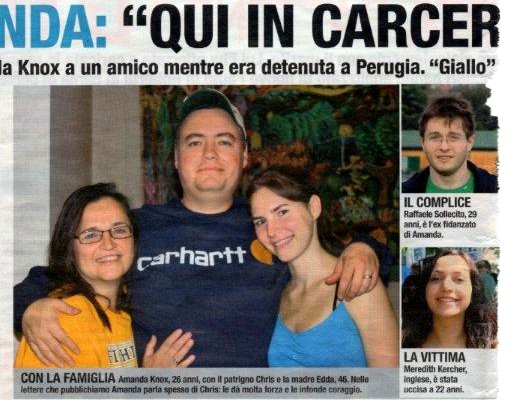
[Header of the Giallo article; the rest off it is at bottom; click for a larger image]
1. The Fake Knox In Her Demonizing Book
Amanda Knox may have felt she was “waiting to be heard” in America but here in Italy we have heard her many times, and we feel we know her pretty well.
Her book and interviews don’t sound like her at all. They sound like nasty legal stunts and nasty PR at work. It is easy to disprove her disparagement of officials and her friends here, and an investigation by the Chief Prosecutor in Bergamo is already under way.
So the big question for us here is not angrily “Who are these appalling police, prosecutor and prison officials, and why did they do these terrible thing?” but sadly “Why was she compelled to invent all this stuff?” and “Why is she so scared to come back?”
2. The Amanda Knox That We In Italy Know
I have translated six of her letters from prison just published in the crime magazine Giallo plus the introduction and the graphologist’s analysis. This is more like the Amanda Knox we know, not the invented one in the book.
1. The Giallo magazine’s Introductory framing of Knox’s letter below
Amanda: “Here In Prison Things Are Okay”
So writes Knox to a friend while she was a prisoner in Perugia. [The true crime magazine] Giallo publishes her letters, and then has them commented on by a graphologist and a psychologist
The letters you see published on these pages are from Amanda Knox, the young American accused, along with her ex boyfriend Raffaele Sollecito, of the murder of the British student Meredith Kercher, that took place in Perugia the 1st of Nov. 2007.
Knox, 26 years old, was acquitted in appeal, but now Cassazione has decided that the appeal must be redone. While waiting for this complicated judicial process to restart, Amanda lives in Seattle, and is traveling around America to launch her new book Waiting to be Heard for which she was paid several million euro by her publisher.
To the American television interviewers, the young American woman has said she is scared of coming back to Italy, because our prisons are terrible places, where she was threatened, molested sexually, and humiliated.
Well, in the letters that Giallo publishes in an exclusive, Amanda writes to a social worker, Maurizio, who helped her, and she seems neither desperate or scared, she has friends and cellmates with which to share many interests, From reading to music, up to manicures. There is a priest, Don Saulo, with which she talks, and confesses, and helps her in her moments of discouragement.
Sure, she suffers from the distance from her family, her loneliness and her imprisonment, but she can see her parents and speak with them frequently, and this notably relieves her suffering.
2. Six letters from Knox to the social worker Maurizio 2008-2010
April 3 2008
Dear Maurizio,
Thank you very much for that letter that for me is very interesting. I was thinking: “Why am I here?”, “why can’t I be with my mother?”, ” Yes the police can think badly about me, and meanwhile I do understand that I have to be in control, not run away from the situation, but why prison? I am 20 years old, never committed a crime, it is senseless. How can they say that I have to stay in prison like the people that can be a danger to others? Above all when they don’t know the truth?
It really is a torture and now I understand the motivation. I understand the motivation, but I do not agree. “Sweet” or not it is a “TORTURE”. I am being tortured and it is not right…...
Sorry. As I said I do suffer a lot in prison. Generally I am scared, alone, with no hope, sad, and tired, even if I am innocent.
Thank you for the article. It is interesting to know how people that do not undergo this torture as I and hundreds others think. To tell you the truth, I can’t understand how some judges can sleep at night, when they very well know that it can be a grave mistake. ah… mamma mia….
Come on! It is O.K. here. I am studying a lot and have started reading Italian Poetry.
Another thing that I like a lot is the song “A te” by Jovanotti. “perché tu sei…semplicemente sei….sostanza dei giorni miei…sostanza dei giorni miei…. (lyric of the song n.d.r.). Have you heard it? According to me it is a live song. It is true. Simple and strong. I like it a lot.
How are you? Do you like the change of weather? I spend more time outside reading a book and singing (I am still alone when I go outside). I am sun tanning but I’m still white white!
Hope you are OK. Love, Amanda
P.S. Let it be! Here comes the sun! I know that I am not alone, even when I am alone
April 28 2008
Dear Maurizo,
Thanks again for your thoughts and your gifts.
I really like the T-shirts and the book of art. Beautiful! Mamma mia the talent of the artists always surprises me! Thanks. But you know, you do not have to buy me anything. I am happy just to hear from you.
Really, [Priest] Don Saulo speaks to me so much about God’s gifts, especially about the strength to overcome the difficult moments, of which there are so many. He bought me a book on philosophy entitled “Umanesimo Integrale” and we speak often of my thoughts and my questions. He is a true friend and a very good man.
It’s true, I must start to read a bit of classic Italian texts. Maybe there are some books in the library for me….......Who can explain to me about “Divina Commedia”? I know it exists and that it is famous, but more than that I am ignorant, unfortunately.
Now my father is here with me, but he has to return to the United States, next week. In his place the husband of my mother, will come. I am happy, because from him I receive a lot of strength. He is like that.
Today I go to the gym course (in a bit) and I have a home telephone call. My first telephone call was last week and I was so excited. The voices of the people I love are really a gift. I trembled a bit after those so little ten minutes.
Now, I must go to the course to sweat a bit. 😊 I hope you are very well. Thanks again for your words.You are very kind.
A hug, Amanda 😊
P.S. Let it be! Here comes the sun! I know I am not alone, even when I’m alone.
November 26 2009
Caro Maurizio,
Ciao, my friend. How are you? It’s from forever that I write you. I imagine that you must have basketball in your head, since it is the season’s sport. I send best wishes to your nephews, who play it. I am terrible at basket. I have very small hands, therefore I can’t control the ball.
I would like to thank you for meeting with my family. Chris told me nice things about your encounter, he was impressed by your generosity. I know that it is always nice and unique, every time that somebody comes toward you and they like you, just like that. Therefore, thank you, for having welcomed him, me and my dear ones.
Nearly, nearly there. O mamma mia, one has to remain strong in these days. I am always hoping so much, even if, in my stomach I feel sick, anxious. More than anything, the closer it gets, the more I have to reinforce my patience against the fatigue and frustration. But I will make it.
A lot of my family will come tomorrow to be in court. There will be my father, my mother, my stepmother and my aunt. My three sisters will be here on Dec. 2. I hope so much to be able to go home with them, finally, this time. I see it in “my third eye” the vision of being on the plane between my mother and my sister. Maybe, I am thinking to much about it.
Anyway, I hope you are well. I must go to sleep early tonight, to be ready for tomorrow.
Thank you for your continued support.
Your friend, Amanda 😊
Here comes the sun! Let it be! I know that I am not alone even when I am alone,
Happy Thanksgiving!
April 20 2010
MAURIZIO
Hi! How are you? I’m happy that I made you happy with the full translation. For me it was a satisfying job, so I thank you too for the chance that you gave me. I don’t think it will be a bad thing put up my name as a translator. OK it is fine for me and yes if you like it, you can even put my second name Marie,
Thank you very much for the towels, to be truthful I really needed them. They are beautiful. I gave one of my pillow cases to the other inmate so we have twin pillows. She thanks you too and sends her best wishes.
Seems like that the weather is finally changing. With great pleasure I was able to wear a skirt in these days. Now people are out and we play volleyball together under the sun. I made friends with a new 19 years old girl: she is an athlete too. Every day we walk or play with the ball together,
Next Friday my mother, father and stepfather will be here for a visit. Mi mother and father are here for a short time to be interviewed on TV at “Quarto Grado” and then will come here. Can’t wait to see them, I miss them with all my heart.
Well, hope that you are fine. Thank you again for everything and salute you with all my affection
Hi your friend, Amanda
I know that I am not alone even when I am alone
August, 30 2010
Dearest Maurizio
Hi dear, how are you? Do you know that yesterday I was taking with D…. about you, only because you are a very special person in this world, for all that you do for others. She told me that you got married. Congratulations! Now I have to tell to my grandmother and break her heart! 😊 Just joking!
I am well enough here. I thank you again for the shorts and shirt that you send me. They were perfect as always. Thanks and I hope that you didn’t lighten your wallet too much. I am kind of disappointed that you spend your money on me, you are too generous. I am always the same here.
Just finished reading a book by Umberto Eco book that I liked a lot. In Italian should be ” L’isola del giorno prima”, I read it in English “The island of the day before”; maybe the “island of yesterday”? Anyway, I was favorably moved by Eco’s organization in this novel in order to communicate so many ideas on science, philosophy, ethic, imagination, literature. It was a book very rich on thoughts, and colpi di scena during it’s path.
I like Umberto Eco because he meticulously builds the story that he wants to tell. Of all he writes, nothing is taken for granted and this is remarkable, he has a fantastic mind to dig deep while following a long track. I saw a Sean Connery movie based on a book of his “Il nome della Rosa?” It was fantastic. Always meticulously built, deep and fascinating.
Seems like that the newspapers know before us when the appeal proceeding will take place. We still have not been officially notified, but my lawyers told me that it should start Nov. 24th; that in the USA is Thanksgiving Day. Hope that it is a good omen even if there is a lot in my life for which I should be grateful: to be alive, having the family that I have etc…
[Undated letter]
Dearest Maurizio,
I am happy to hear from you again. I use now the paper you sent me to answer you. Sorry to make you wait. My mother has returned to the United States nearly a week ago, and my father returns to Italy tomorrow, to see me Tuesday.
I am happy to remain in Perugia. I do not want to restart everything in another place. Also I? (blurred) have heard that the prisons in Rome are harsher than here. Who knows?
I only know that at least I know some of the prison officers fairly well, after all this time. I would be sorry to leave Don Saulo. I feel fine in my new cell. I changed it so I could be with a girl my own age. We joke, cook, we do manicures. Further, she does a manicure for me, because I do not know how to do one. We listen to music a lot because she has a radio.
Thank you for all you do for me. The paper, your words of confidence, your prayers. To Don Saulo I will send your greetings. Do you write often to him too? I hope all is very well with you. I send you a big hug. Ciao! Thank you!
Amanda Knox 😊
Let it be, Let it be! Here comes the sun! (drawing of a sun)
3. Comments by educational psychologist and graphologist Evi Crotti
Looking at the Amanda Knox letters it is evident right away how organized and precise she is: she has a perfect handwriting, elegant and without smudges. We try to interpret it with the help of the graphologist and educational psychologist Evi Crotti.
She explains: Her perfect, organized handwriting, without margins and few spaces indicates that we have before us a girl that is decisive, strong, who wants to dominate, and knows she can succeed in life. She puts herself In the center and leaves no place for others. Amanda displays a way of writing that is typically northamerican, in small print, called script.
The handwriting, elegant, big and curved, reveals an extroverted personality, and with a notable sense of taste. Her language is fluid and polished, and the accuracy with which she writes, tells us that this young girl has a need to maximize and nurse her image, to the point of becoming narcissistic: after her signature she draws herself with a smiling face.
Amanda leaves no space between the lines: this signifies an element of interior loneliness, which she attempts to compensate at any cost with approaches of verbal intrusiveness. This tells us that that her strong narcissistic behavior can escape control and lead her to present unstable behaviors. The fact instead that her handwriting is always in horizontal lines, without blurs, gives testimony to her practical intelligence and her strong tenaciousness, that allow her to reach her goals.
Also, the handwriting is rigid and this signifies that she knows how to use words with care and determination. Evi Crotti underlines that the handwriting is static: It is a sign of a behavior that is very seductive. Attention, the need to be attractive at all costs can make her lose sight of the objectivity of judgment , taking her to a subjective vision of circumstance reality.
Conclusion: Amanda seems to be in a continuous search of approval and acceptance from those who live around her. Her egocentricity, maybe pushed unto the point of a bogus personality, demonstrates that this girl possess a highly emotional immaturity that doesn’t allows her to love in an unselfish way. The handwriting slightly slanted to the left indicates a contradiction between the need to be liked and the reactive refusal toward a feminine figure: for her, probably every woman represents a rival.
Sunday, May 12, 2013
With Diffamazione Complaint Against False Claims In Oggi Knox’s Legal Prospects Continue To Slide
Posted by Our Main Posters
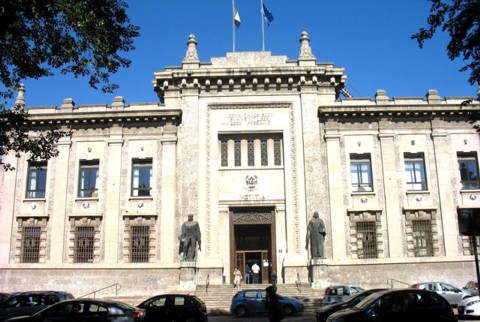
[Above: the Palace of Justice in Bergamo where Knox and Sollecito might spend some time]
Knox’s public relations campaign is starting to look very, very odd.
As many of our recent posts have explained, no really good lawyer in Italy would ever allow their clients to put out an inflammatory book while their legal process is still going on. It hasn’t happened in any other Italian cases in years.
And now in this case it has happened twice.
Sollecito’s book reeked of blood money, arrogance and contempt, it twisted and discounted much of the evidence, made claims which both Sollecito and others had previously contradicted, made accusations of criminal behavior against officers of the court, and separated himself from Knox.
Now guess what?
Despite the fact that Sollecito’s book was promptly dispatched to the Florence and Verona chief prosecutors with diffamazione and vilipendio complaints, Knox’s book too reeked of blood money, arrogance and contempt, it too twisted and discounted much of the evidence, it too made claims which both Knox and others had previously contradicted, it too made accusations of criminal behavior against officers of the court, and it separated her from her co-perp.
In each case there was a shadow writer, respectively Andrew Gumbel and Linda Kulman, who seem to have tired early on of the clients, as all their hired help tends to do, and simply copied the FOA playbook into the books with no sources at all checked beyond that narrow group.
To cool-headed and informed people who really know the case, Gumbel’s sources were rather a joke. PR shills Nina Burleigh and Candace Dempsey and Steve Moore? Really? And Linda Kulman seems to have fallen into the same trap.
This becomes very obvious when you watch the two “authors” at their interviews. They are both hampered and tongue-tied because for the life of them neither can remember what their shadow writers put in the books. Several interviewers have actually caught them out.
As we knew the Bergamo lawsuit against Oggi and Knox was headed down the pike, we set out what we consider to be the state of play last Friday. It still stands up, but might be embellished just a bit.
First, here is Andrea Vogt’s helpful description of what’s in the Bergamo complaint..
The 8-page complaint is addressed to the Prosecutor’s Office in Bergamo (near Milan), where the headquarters of the magazine are located. It cites as slanderous the suggestion that Knox was illegally interrogated and maintains that there is no trial or investigation documentation supporting a number of “affirmations that were never made.” Mignini insists Knox was initially heard by him as a witness with key information relevant to the murder of Meredith Kercher, not as a suspect herself.
“Knox never asked for an attorney. She wanted to talk,” Mignini wrote, adding that he did not contest her statements or question her at that time, because she was making a spontaneous declaration regarding Patrick Lumumba’s alleged involvement. [In other words, not about herself.]
The complaint also questions allegations of prison mistreatment and indicates specific persons and neutral institutions as having knowledge on the matter, including the Capanne prison chaplain, U.S. embassy officials, center-right politician Rocco Girlanda and secretary general of the Italy-USA Foundation Corrado Daclon, all of whom visited Knox regularly in prison.
Also contested are phrases reported by Oggi and attributed to Knox’s memoir claiming he had a bizarre past that included a conviction on abuse of office charges that was pending appeal, when in fact he was fully and definitively acquitted of those charges in 2011 by a Florence court.
Italy’s high court (Cassation) recently agreed with his office’s request to re-open the Monster of Florence/Narducci case, the complaint notes. That decision has lent new credence to his long-running investigation of the suspicious 1985 death of a Perugian doctor who some investigators believe was involved (Italy’s Cassation Court in March also ordered Mario Spezi, co-author of the Monster of Florence bestseller, to stand trial for allegedly attempting to pin the blame on another man).
While the targets of the suit are stated to be Oggi and Amanda Knox and her publishers, the REAL target appears set to be the FOA playbook as set out in Amanda Knox’s book. And for that matter in Raffaele Sollecito’s book.
The first complainant (there are expected to be others) Giuliano Mignini has advanced a request for a formidable slate of witnesses, which could come to include even the lawyers for Sollecito and Knox.
Won’t that be fun. As they are interrogated on the stand, each witness is going to have to take a position on what crazy stuff the FOA have pushed into the books.
Did the prosecutor offer Sollecito an illegal deal or not? Did Knox get interrogated about Patrick by the prosecutor while denying her a lawyer or not? Did Knox complain to her lawyers about conditions in prison and if so why do those lawyers and so many others say she did not?
And maybe fifty more sudden-death choices like the above. Gee thanks Oggi and Amanda Knox. This could set some facts straight, in front of the whole world.
Demonizations By Knox: OGGI Charged For Article Conveying False Claims To Italy #2
Posted by Our Main Posters
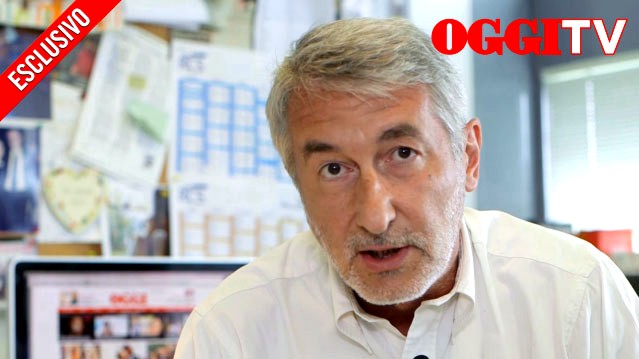
[Umberto Brindani, editor of Oggi, a Mario Spezi ally, being sued for publishing Knox’s claims in Italy]
The decision of Amanda Knox and her lawyers and publishers to flaunt her dishonest claims in Italy seems seriously ill advised.
Pouring gasoline on the fames, it has opened up a fast-track way for those many who she nastily attacks to put the real truths in front of the world. Nobody who foolishly parrots her will be immune from being required to testify by the courts, her own lawyers included.
Here are our own short rebuttals of the Knox claims Oggi specifically flaunts to Italy in its unresearched review.
- Knox was NOT interrogated for days and nights. She was put under no pressure in her brief witness interviews except possibly by Sollecito who had just called their latest alibi “a pack of lies”.
- Knox WAS officially investigated in depth, after she surprisingly “confessed” and placed herself and Patrick at the scene. Prior to that she’d been interviewed less than various others, who each had one consistent alibi.
- Knox herself pushed to make all three statements without a lawyer on the night of 5-6 November 2007 in which she claimed she went out from Sollecito’s house, met Patrick, and witnessed him killing Meredith.
- Far from Knox being denied a lawyer, discussions were stopped before the first statement and not resumed, in the later hearing she was formally warned she needed one; she signed a confirmation of this in front of witnesses.
- Prosecutor Mignini who Knox accuses of telling her a lawyer would hurt her prospects when she claims she asked for one was not even in the police station at that interview; he was at home.
- She was not prohibited from going to the bathroom. At trial, she testified she was treated well and was frequently offered refreshments. Her lawyers confirmed this was so.
- She was not given smacks by anyone. Over a dozen witnesses testified that she was treated well, broke into a conniption spontaneously, and thereafter was hard to stop talking.
- There is no evidence whatsoever that Knox was subject to “something similar to torture” and as mentioned above only Sollecito applied any pressure, not any of the police.
- There is nothing “suicidal” about returning to Italy to defend herself at the new appeal. Sollecito did. She risks an international arrest warrant and extradition if she doesn’t.
- There is no proof except for her own claims of sexual molestations in prison; she is a known serial liar; and she stands out for an extreme willingness to talk and write about sex.
- Many people have testified she was treated well in prison: her own lawyers, a member of parliament, and visitors from the US Embassy were among them; she herself wrote that it was okay.
- She may have based her account on her diaries and “prodigious memory” but the obviously false accusation against the prosecutor suggests that much of the book was made up.
- The investigators had a great deal of evidence against Knox in hand, not nothing, and they were not ever faulted for any action; they helped to put on a formidable case at trial in 2009.
- “Police and Italian justice work with such incompetence, ferocity, and disdain for the truth” is contradicted by a very complete record prior to trial which was praised by the Supreme Court.
- Mr Mignini has NO bizarre past at all. He is widely known to be careful and fair. He would not have been just promoted to first Deputy Prosecutor General of Umbria otherwise.
- He was put on trial by a rogue prosecutor desperate to protect his own back from Mignini’s investigations; the Supreme Court has killed the trumped up case dead.
- There was nothing “mysterious” about Knox being taken to the crime scene to see if any knives were gone, but her wailing panic when she saw the knives was really “mysterious”.
- Knox never thought she was in prison for her own protection; she had signed an agreement at the 5:00 am interview confirming she did know why she was being held.
- Monica Napoleoni did not “bluff” that Sollecito had just trashed their joint alibi; he actually did so, because his phone records incriminated him; he agreed to that in writing.
- There was no crescendo of “yelling and intimidations that lasts from 11 at night until 5.45”. There were two relatively brief sessions. Knox did most of the talking, named seven possible perps, and drew maps.
- There was zero legal requirement to record the recap/summary interview, no recording has “gone missing” and many officers present testified to a single “truth” about what happened.
Demonizations By Knox: OGGI Charged For Article Conveying False Claims To Italy #1
Posted by Our Main Posters

The popular Italian magazine Oggi was sent a review copy of Knox’s book by somebody in the United States.
Oggi has been a frequent vehicle for the Knox entourage version of events, and it has carried a number of lurid pro-Knox splashes. The magazine has a long history of nasty jabs at prosecution and police who as career civil servants under unusually strong rules have no easy ways of explaining their side.
Like all of Oggi’s articles on the case, this shrill and foolish piece is totally one-sided and absolutely unresearched.
- Oggi is ignorant of the fact that many days of testimony by police officers at trial in 2009 contradict Knox’s book, highly convincing testimony, to which Knox on the stand had only the most feeble and unconvincing of responses.
- Oggi is ignorant of the fact that Judge Massei and even Judge Hellmann disbelieved her, and (in extensive reasoning) the Supreme Court (make sure to read parts 3, 7 and 15 there).
- Oggi is ignorant of the fact that Knox was sentenced to three years in prison for the criminal framing of Patrick, and that sentence was confirmed both by Judge Hellmann and the Supreme Court - in effect, unless new FACTS come to light, the truth is known and the case is closed.
The book is already (see next post) the subject of a lawsuit which was filed Friday in Bergamo, where Oggi has its headquarters. Knox is also expected to be investigated for contempt of court. Her book carries at least one no-contest false accusation of a crime: Knox claims the much respected Prosecutor Mignini illegally interrogated her without a lawyer and attempted to make her definitively accuse Patrick Lumumba. This is repeated below. In fact Mr Mignini was not even there.
This translation below of the Oggi piece is by our main poster Catnip. Passages that can EASILY be shown to be false (Oggi would have known they were false with a mere 3-4 hours of research) are highlighted here.
See our own rebuttals in this next post.
Amanda Knox: The American girl’s sensational story
Chilling. No other adjectives come to mind after having read Waiting to be Heard, finally released in the United States. An extremely detailed and very serious charge against the police and magistrates who conducted the investigation into the murder of Meredith Kercher.
Immediately after the crime, Amanda recounts, and for entire days and nights, they had interrogated the American girl and placed her under pressure to make her confess to a non-existent truth, without officially investigating her, denying her the assistance of a lawyer, telling her lies, even prohibiting her from going to the bathroom and giving her smacks so as to make her sign a confession clearly extorted with something similar to torture.
And now the situation is very simple. There are only two choices: either Amanda is writing lies, and as a consequence the police officers and magistrates are going to have to sue her for defamation; or else she is telling the truth, and so they are going to have to go, not without being sanctioned by the CSM [the magistrates’ governing body] and the top brass of the Police. The third possibility, which is to pretend that nothing has happened, would be shameful for the credibility of our judicial system.
Amanda Knox has written her Waiting to be Heard memoir with the sense of revulsion and of relief of someone who has escaped by a hair’s breadth from a legal disaster, but has got her sums wrong. Cassation has decided that the [appeal] proceedings have to be redone and the hearings should be (re)commencing in October before the Florence Court of Appeal.
In a USA Today interview, Ms Knox has not excluded the possibility of “returning to Italy to face this battle too”, but it would be a suicidal decision: it’s likely that the appeal will result in a conviction, and the Seattle girl will end up in the black hole from which she has already spent 1,427 days.
In this way Waiting to be Heard risks being the “film” on which Amanda’s last words are recorded about the Mystery of Perugia, her definitive version.
We have read a review copy. And we were dumbfounded. Waiting to be Heard is a diary that has the frenetic pace of a thriller, written in a dry prose (behind the scenes is the hand of Linda Kulman, a journalist at the Huffington Post), even “promoted” by Michiko Kakutani, long-time literary critic at the New York Times.
The most interesting part does not concern the Raffaele Sollecito love story (which Amanda reduces it to puppy love: “With the feeling, in hindsight, I knew that he… that we were still immature, more in love with love than with each other”), and whoever goes looking for salacious details about the three Italian boys Amanda had casual sex with, one night stands, will be frustrated (Ms Knox describes those encounters with the nonchalance of an entomologist disappointed with his experiments: “We undressed, we had sex, I got dressed again with a sense of emptiness”).
There are no scoops about the night of the murder and even the many vicissitudes endured during the 34,248 hours spent in Capanne prison - the [claimed] sexual molestations suffered under two guards, the unexpected kiss planted by a bisexual cellmate, the threats made by another two prisoners - remain on the backdrop, like colourful notations.
Because what is striking and upsetting, in the book, is the minute descriptions, based on her own diaries, on the case documents and on a prodigious memory, of how Ms Knox had been incriminated (or “nailed”).
COME IN KAFKA. A Kafkian account in which the extraordinary naivety of Amanda (the word naïve, ingénue, is the one which recurs most often in the 457 pages of the book) mixes with the strepitous wickedness of the investigators decided on “following a cold and irrational trail because they had nothing better in hand”.
Devour the first 14 chapters and ask yourself: is it possible that the Police and Italian justice work with such incompetence, ferocity, and disdain for the truth? You place yourself in her situation and you scare yourself: If it happened to me? You’re in two minds: is it a likely accusation, or a squalid calumny, the version of Amanda?
Because in reading it you discover that in the four days following the discovery of Meredith Kercher’s body (on 2 November 2007), Amanda was interrogated continuously, and without the least of procedural guarantees [=due process].
She changes status from witness to suspect without being aware of it.” No one had told me my rights, no one had told me that I could remain silent”, she writes. When she asked if she had the right to a lawyer, the Public Prosecutor, Giuliano Mignini, had responded like this: “No, no, that will only worsen things: it would mean that you don’t want to help us”. Thus, the Public Prosecutor, Giuliano Mignini.
For a long period of time, Ms Knox, who at the time spoke and understood hardly any Italian at all, mistook him for the Mayor of Perugia, come to the police station to help her.
Then, with the passage of time and of the pages, the assessment changes: Mignini is a prosecutor “with a bizarre past”, investigated for abuse of office (he was convicted at first instance, but Cassation annulled the verdict on the grounds of lack of jurisdiction: the case will be tried again in Florence) and with the hunger to fabricate “strange stories to solve his cases”.
Mignini “is a madman who considers his career more important than my liberty or the truth about the killing of Meredith”. On the phone, the Perugian prosecutor reacts with aplomb: “First I will read the book and then I will consider it. Certainly, if it really calls me “˜mad’ or worse, I think I will file suit”.
BEING IN PRISON IS LIKE CAMPING Amanda goes looking. When the officers mysteriously bring her along to the crime scene inspection of the apartment below the one in which she and Meredith were living in, Ms Knox put on the shoe protectors and the white forensics gloves and called out “ta-dah!” spreading her arms “as if I was at the start of a musical: I wanted to appear helpful”.
When they dragged her in handcuffs into Capanne Prison, she believed what the Police would have told her, and that was they would hide her for a couple of days to protect her (from the true killer, one presumes) and for unspecified bureaucratic reasons. “In my head I was camping: ‘This won’t last more than a week in the mountains’ I told myself” writes Amanda.
They take her money off her, and her credit cards, licence [?] and passport, and she draws strength from repeating to herself that “surely they’re not going to give me a uniform, seeing that I’m a special case and that I’ll be here for only a little while”.
But it’s the account of the notorious interrogation that takes the breath away. Around ten in the evening on her last day of freedom, Ms Knox accompanies Raffaele to the police station (he was called in, also without a lawyer, by the Police) and is thrown into a nightmare which she populates with many faces: there is Officer Rita Ficcara, who gives her two cuffs on the head (“To help you remember” she would say); there’s another officer who advises her: “If you don’t help us, you’ll end up in prison for 30 years”; Mignini arrives and advises her not to call a lawyer; super-policewoman Monica Napoleoni dives in and bluffs: “Sollecito has dropped your alibi: he says that on the night of the murder you had left his apartment and that you had told him to lie to ‘cover you’ “.
And a crescendo of yelling and intimidations that lasts from 11 at night until 5.45 in the morning. Seven hours “produce” two confessions that, exactly because they are made without a defence lawyer, cannot be used in the proceedings, but forever after “stain” the image of the accused Knox: Amanda places herself at the scene of the crime and accuses Patrick Lumumba.
RAFFAELE CONFIRMS THE ACCUSATIONS An account of the horror is confirmed by Sollecito in his memoir, Honor Bound, Raffaele writes of having heard “the police yelling at Amanda and then the cries and sobs of my girl, who was yelling “Help!” in Italian in the other room, and of having being threatened in his turn (“If you try to get up and go, I’ll punch you till you’ll bleed and I’ll kill you. I’ll leave you in a pool of blood”, another officer had whispered to him).
Published lines which have passed right under the radar of the Perugian investigators: “No legal action [against the interrogators] has been notified to us,” Franco Sollecito, Raffaele’s dad, tell us. For having recounted the sourness of her interrogation in court, Amanda was investigated for calunnia: the trial will take place in Florence. This one, too, will be a circumstantial case: it’s the word of two young people against that of the public prosecutor and the police.
The recording of the interrogation would have unveiled which side the truth stands on. But it has gone missing.
See our own rebuttals in this next post.
Below: images of the 4-page Oggi spread. Click for larger versions to read.

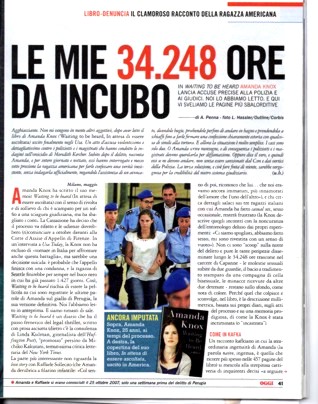
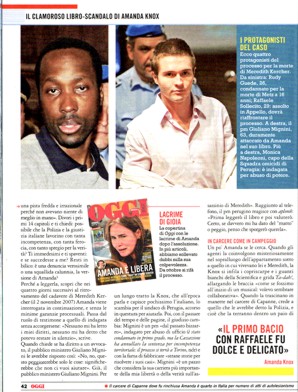
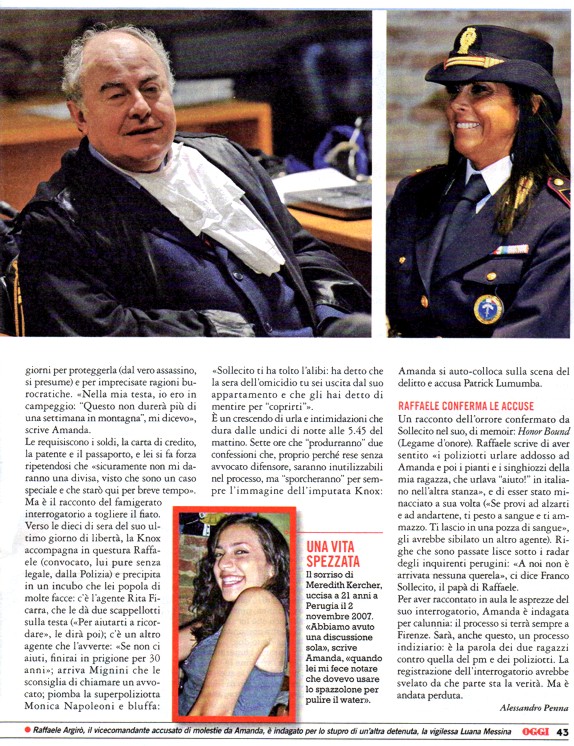
Thursday, May 09, 2013
Demonizations By Knox: She Invents An Illegal Interrogation By Mignini That Never Took Place
Posted by Our Main Posters

[The Perugia Central Police Station where Knox’s imaginary interrogation “took place”]
It is hard to imagine a more extreme form of contempt of court than Knox falsely accusing a respected prosecutor of interrogating her without her lawyer being present, and pressing her to incriminate others.
For this alone, Knox will certainly be investigated and charged. No wonder she is “scared” of returning to Italy. Apart from fears of getting up on the stand, she has lied about and falsely accused way too many people there.
1. What actually happened at Knox’s witness and suspect interviews:
Here is the true account, which has many witnesses, and then her account in the book, which has none.
Before 3:00 AM on 6 November 2007 the respected senior prosecutor Giuliano Mignini had barely set eyes on Amanda Knox.
At that point in time, she had just passed through a purely voluntary witness questioning with the police, who were actually much further ahead in questioning Sollecito and Knox’s flatmates and Meredith’s English friends.
Dr Mignini was at home asleep, but on call if the central police station needed him that night, which is how quite by chance he came face to face with Knox not long before dawn.
Knox’s latest alibi had just been collapsed in another witness interview room. Sollecito had collapsed their joint alibi almost instantly when shown phone records that proved he had just lied. He then declared their current alibi to be a pack of lies.
Told of this, Knox then floundered for a new explanation, turning finally to fingering her employer Patrick Lumumba who the police did not even know to exist until her phone record showed he did.
Police took down that statement, Knox signed it, and this at 3:00 am was the state of play.
Knox was in a waiting room and not under arrest. Mignini was required to warn Knox of her rights as a new suspect, and to warn her to do no further talking to him or anyone else around without a lawyer present.
This was especially so as Knox was inclining to babble on and on and officers were trying to calm her down. As the police had just found (and as her own lawyers later found) she can prove very difficult to stop.
This relatively brief meeting (in which Mignini made quite clear who he was, witnesses confirm) was extended to allow Knox to fine-tune her accusation of Patrick.
She shrugged off the right to have her lawyer there. Prior to this, Knox to Mignini was simply one of a whole lot of people who might be of interest, nothing more.
2. Knox’s invented version of the witness interview which never happened
This interrogation quoted from Knox’s book below is already attracting serious attention in Italy. Why? Because its just not her babbley tone, and because it never even took place.
Amanda Knox, Waiting To Be Heard, HarperCollins, Pages 90-92
[Description is of the end of Knox’s voluntary witness interview with police which Mignini did not attend; the most damaging claims are in bold]
Eventually they told me the pubblico ministero would be coming in.I didn’t know this translated as prosecutor, or that this was the magistrate that Rita Ficarra had been referring to a few days earlier when she said they’d have to wait to see what he said, to see if I could go to Germany.
I thought the “public minister” was the mayor or someone in a similarly high “public” position in the town and that somehow he would help me.
They said, “You need to talk to the pubblico ministero about what you remember.”
I told them, “I don’t feel like this is remembering. I’m really confused right now.” I even told them, “I don’t remember this. I can imagine this happening, and I’m not sure if it’s a memory or if I’m making this up, but this is what’s coming to mind and I don’t know. I just don’t know.”
They said, “Your memories will come back. It’s the truth. Just wait and your memories will come back.”
The pubblico ministero came in.
Before he started questioning me, I said, “Look, I’m really confused, and I don’t know what I’m remembering, and it doesn’t seem right.”
One of the other police officers said, “We’ll work through it.”
Despite the emotional sieve I’d just been squeezed through, it occurred to me that I was a witness and this was official testimony, that maybe I should have a lawyer. “Do I need a lawyer?” I asked.
He said, “No, no, that will only make it worse. It will make it seem like you don’t want to help us.”
It was a much more solemn, official affair than my earlier questioning had been, though the pubblico ministero was asking me the same questions as before: “What happened? What did you see?”
I said, “I didn’t see anything.”
“What do you mean you didn’t see anything? When did you meet him?”
“I don’t know,” I said.
“Where did you meet him?”
“I think by the basketball court.” I had imagined the basketball court in Piazza Grimana, just across the street from the University for Foreigners.
“I have an image of the basketball court in Piazza Grimana near my house.”
“What was he wearing?”
“I don’t know.”
“Was he wearing a jacket?”
“I think so.”
“What color was it?”
“I think it was brown.”
“What did he do?”
“I don’t know.”
“What do you mean you don’t know?”
“I’m confused!”
“Are you scared of him?”
“I guess.”I felt as if I were almost in a trance. The pubblico ministero led me through the scenario, and I meekly agreed to his suggestions.
“This is what happened, right? You met him?”
“I guess so.”
“Where did you meet?”
“I don’t know. I guess at the basketball court.”
“You went to the house?”
“I guess so.”
“Was Meredith in the house?”
“I don’t remember.”
“Did Patrick go in there?”
“I don’t know, I guess so.”
“Where were you?”
“I don’t know. I guess in the kitchen.”
“Did you hear Meredith screaming?”
“I don’t know.”
“How could you not hear Meredith screaming?”
“I don’t know. Maybe I covered my ears. I don’t know, I don’t know if I’m just imagining this. I’m trying to remember, and you’re telling me I need to remember, but I don’t know. This doesn’t feel right.”
He said, “No, remember. Remember what happened.”
“I don’t know.”At that moment, with the pubblico ministero raining questions down on me, I covered my ears so I could drown him out.
He said, “Did you hear her scream?”
I said, “I think so.”My account was written up in Italian and he said, “This is what we wrote down. Sign it.”
To repeat, Mignini was not even present at the midnight interrogation of Knox by the police, and he certainly never edged her into fingering Lumumba as is being claimed here. Knox herself did that all by herself in the presence of the police.
And she did it again and again. Emphatically.
[Dalla Vedova and Ghirga: did they illegally allow Knox to commit serious felonies in the book?]
